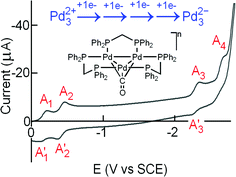The Pd3(dppm)3(CO)nclusters (n = 1−,2−); rare cases of anionic palladium species
Abstract
Two novel anionic

* Corresponding authors
a
Institut de Chimie Moléculaire de l'Université de Bourgogne (ICMUB), UMR 5260, 9 avenue Alain Savary, Dijon, France
E-mail:
Yves.Mugnier@u-bourgogne.fr
Fax: 33 (0)3 80 39 60 91
Tel: 33 (0)3 80 39 60 91
b
Département de Chimie, Université de Sherbrooke, Sherbrooke, PQ, Canada
E-mail:
Pierre.Harvey@USherbrooke.ca
Fax: 819-821-8017
Tel: 819-821-7092
Two novel anionic

 Please wait while we load your content...
Something went wrong. Try again?
Please wait while we load your content...
Something went wrong. Try again?
S. D. Molin, Y. Mugnier, D. Fortin and P. D. Harvey, Dalton Trans., 2010, 39, 8976 DOI: 10.1039/C0DT00616E
To request permission to reproduce material from this article, please go to the Copyright Clearance Center request page.
If you are an author contributing to an RSC publication, you do not need to request permission provided correct acknowledgement is given.
If you are the author of this article, you do not need to request permission to reproduce figures and diagrams provided correct acknowledgement is given. If you want to reproduce the whole article in a third-party publication (excluding your thesis/dissertation for which permission is not required) please go to the Copyright Clearance Center request page.
Read more about how to correctly acknowledge RSC content.
 Fetching data from CrossRef.
Fetching data from CrossRef.
This may take some time to load.
Loading related content
